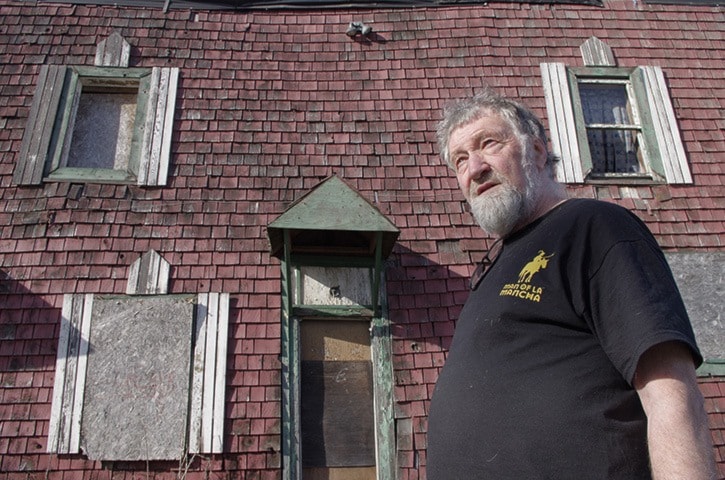It’s been seven years since Norm Abbey and his neighbours started complaining about the former home of the Spanglish convenience store at 144 Victoria Rd.
Since 2007 the property has changed hands several times, was heavily damaged by a fire in 2007 and is now boarded up and uninhabitable – rooms were rented from the building’s second storey before the fire – but it and other derelict properties in the neighbourhood still vex residents.
“Our neighbourhood association has complained about that building, in writing, to the RCMP and to Randy Churchill [city manager of bylaw services] ever since 2007,” Abbey said. “We submitted a huge file of personal complaints.”
Those complaints concerned suspected drug and prostitution activity in and around the property, which finally resulted in the city labelling it at the time as a nuisance property.
But seven years later, the building still stands vacant, aside from whoever sneaks through an open back door.
A boarded-up, burned-out house at 71 Strickland St. also raises queries as to why it takes so long to do something about derelict structures in Nanaimo.
Most cities have abandoned buildings, but there are those in Nanaimo, such as a concrete structure never completed at 951 Haliburton St. dating back to the 1980s, that just seem to lay dormant for decades.
Abbey argues neighbours shouldn’t have to wait years for the city to deal with these structures, especially when they cost the city money for such things as callouts for Nanaimo Fire Rescue to snuff out fires sparked by squatters.
“Penticton has a bylaw that does deal with derelict buildings and they do it in 60 days,” Abbey said.
Provisions in the City of Penticton Good Neighbour Bylaw require vacant buildings to be registered with the city and owners to apply for permits allowing the building to be unoccupied for a specific period. If the building is unsafe or violates bylaw provisions the city will issue an order to bring it into compliance with the bylaw. Failure to do so within 30 days means the city can order buildings demolished and claim cleanup costs against the owner or from the sale of the property.
Churchill said Nanaimo already has tools under its community charter to deal with problem properties. The charter requires owners to keep buildings secure, prevent squatting, remove graffiti, keep them from becoming unsightly and unsafe, and to keep them structurally sound.
“If they’re occupied they have to have passed building inspection and be fit from a fire and building [code] perspective,” Churchill said. “A building that isn’t posing a safety issue can be boarded up and can sit there for a period of time. Where we become concerned, as a city, is more when it reaches a condition of really being dilapidated to the extreme and it becomes unsafe or structurally unsound. That’s when the city gets involved.”
When structures get too run down they can be brought before city council to determine their fate.
“That depends on what it is,” Churchill said. “Is it unsafe? Is it structurally unsound or is it unclean and dilapidated to the point of causing a neighbourhood concern, so that could lead us to demolition. It could lead to someone fixing it, bringing it back into a structurally sound condition. It could be that someone cleans it up so that it is no longer derelict or dilapidated in appearance.”
One consideration among a long list is whether bringing a building up to code will cost more than 75 per cent of the structure’s value. If so, council can move to have the building taken down.
There are also considerations over private property rights and the privacy of the owners or occupants, so due process has to be followed. A building with peeling paint and unpleasant looking doesn’t mean it is unsafe or a public safety issue.
The city took immediate action March 6, revoking an occupancy permit to a home on Estevan Road that partially collapsed. The city is currently working with the owner to see determine if the home can be salvaged. Churchill said each case has its unique set of circumstances.
For privacy concerns Churchill won’t publicly discuss what properties are on the city’s list to be dealt with, but many are on the list because of complaints filed by neighbourhood associations.
“We did our research and tabulation and gathered the information last year,” Churchill said. “Now we’re in a process where you’ve already got a few of them that are in stream and have already gone through council and you’ve got more coming. That’s where we’re at.”
Churchill estimates about one or two buildings will be dealt with per month.
Most complaints are brought to the attention of the Safer Nanaimo Advisory Committee, which includes representatives from city council, Island Health, the RCMP, the city, Downtown Nanaimo Business Improvement Association, Nanaimo’s Working Group on Homelessness and two members of the public.
“I happen to know that Randy has a fairly extensive list and it is doable, but it’s considerable and we’re doing them one at a time,” said Coun. Fred Pattje, committee chairman.
As for the Penticton bylaw, Pattje said he had not studied it, but is willing to look at ideas from other communities.
“If that list of Randy’s becomes too long then obviously, we should be looking at something different if there’s a possibility to do that, provided it fits in with the provision of the community charter,” Pattje said. “That’s still the guiding light.”
